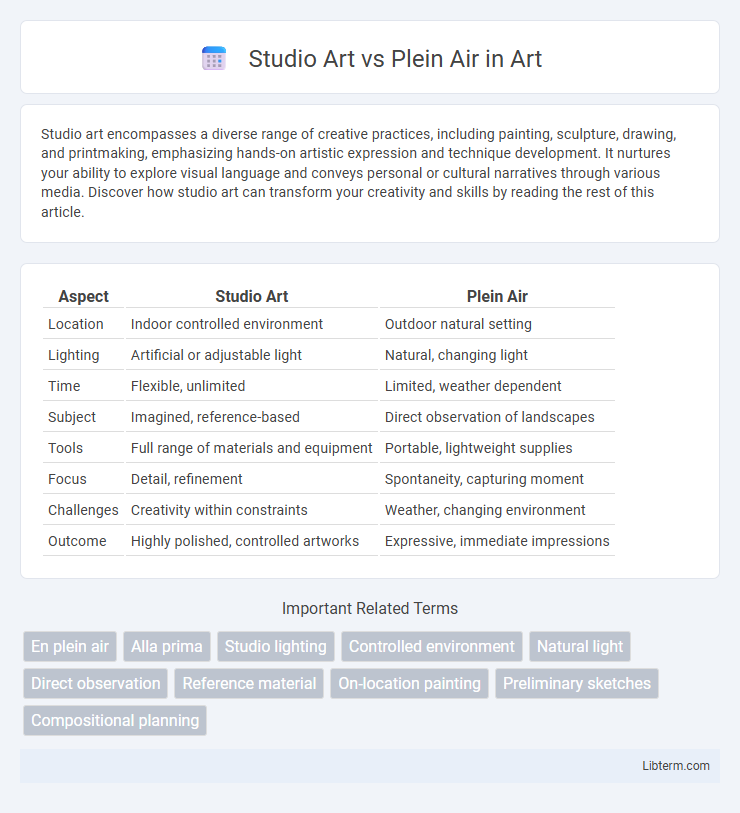Studio art encompasses a diverse range of creative practices, including painting, sculpture, drawing, and printmaking, emphasizing hands-on artistic expression and technique development. It nurtures your ability to explore visual language and conveys personal or cultural narratives through various media. Discover how studio art can transform your creativity and skills by reading the rest of this article.
Table of Comparison
| Aspect | Studio Art | Plein Air |
|---|---|---|
| Location | Indoor controlled environment | Outdoor natural setting |
| Lighting | Artificial or adjustable light | Natural, changing light |
| Time | Flexible, unlimited | Limited, weather dependent |
| Subject | Imagined, reference-based | Direct observation of landscapes |
| Tools | Full range of materials and equipment | Portable, lightweight supplies |
| Focus | Detail, refinement | Spontaneity, capturing moment |
| Challenges | Creativity within constraints | Weather, changing environment |
| Outcome | Highly polished, controlled artworks | Expressive, immediate impressions |
Introduction to Studio Art and Plein Air
Studio Art emphasizes creating artworks within a controlled indoor environment, allowing artists to manipulate lighting, materials, and composition meticulously. Plein Air painting involves working outdoors to capture natural light, atmosphere, and immediate surroundings, fostering spontaneous and dynamic expressions. Both approaches develop distinct skills: Studio Art refines precision and technique, while Plein Air enhances observational acuity and adaptability to changing conditions.
Historical Background of Both Practices
Studio art dates back to the Renaissance, where artists like Leonardo da Vinci and Michelangelo developed detailed works in controlled indoor environments, emphasizing precision and technique. Plein air painting emerged prominently in the 19th century with the Impressionists such as Claude Monet, who prioritized capturing natural light and transient moments by working outdoors. The shift from studio to plein air reflected broader artistic movements toward realism and immediacy in visual representation.
Key Differences in Creative Process
Studio art allows artists to control lighting, environment, and materials, fostering meticulous detail and extended experimentation. Plein air painting requires quick adaptation to changing natural light and weather, emphasizing spontaneity and capturing the essence of outdoor scenes. The creative process in studio art leans toward refinement, while plein air prioritizes immediacy and dynamic response to the environment.
Materials and Tools Used
Studio art primarily utilizes controlled environments with a wide range of materials including oil paints, acrylics, charcoal, and mixed media, supported by easels, canvases, brushes, and palettes tailored for detailed work. Plein air painting demands portability and durability in materials and tools, often featuring lightweight easels, portable paint sets, quick-drying mediums like acrylics or watercolors, and specialized brushes designed for outdoor conditions. Both mediums require high-quality surfaces such as canvas or paper, but plein air emphasizes compact, easy-to-transport supplies to adapt to dynamic natural lighting and weather.
Environmental Influences on Artwork
Studio art offers controlled lighting and stable conditions that allow artists to meticulously refine details and colors without environmental disruptions. Plein air painting captures the dynamic effects of natural light, weather, and atmosphere, creating artwork imbued with the immediacy and changing moods of the outdoor environment. Environmental influences such as shifting sunlight, temperature, and wind directly impact brushstrokes, color palettes, and compositions, lending plein air works a sense of spontaneity and authenticity.
Benefits of Studio Art
Studio art offers controlled lighting, allowing artists to perfect details and achieve consistent color accuracy throughout their work. The indoor environment eliminates weather-related interruptions, providing uninterrupted creative focus and extended working hours. Access to a wide range of materials and reference resources in the studio enhances experimentation and the refinement of complex techniques.
Advantages of Plein Air Painting
Plein air painting offers the advantage of capturing natural light and atmospheric conditions directly, resulting in more vibrant and authentic color representation. Artists experience immediate sensory engagement with their environment, enhancing emotional connection and spontaneity in their work. This method promotes quicker execution and adaptability, leading to dynamic compositions that reflect real-time changes in weather and lighting.
Challenges Faced by Studio and Plein Air Artists
Studio artists encounter challenges such as limited natural light, reliance on artificial lighting, and potential disconnection from the subject's environment, which can hinder capturing authentic atmospheres. Plein air artists face unpredictable weather conditions, changing light, and physical discomfort from outdoor elements, demanding quick decision-making and adaptability. Both approaches require unique skill sets to overcome these obstacles while maintaining artistic integrity and expression.
Techniques Unique to Each Practice
Studio art techniques emphasize controlled environments, allowing artists to manipulate lighting, composition, and color with precision, often using layered brushwork and glazing for detailed effects. Plein air painting requires rapid execution and adaptability to changing natural light, favoring direct application of paint, alla prima methods, and simplified brushstrokes to capture ephemeral atmospheric conditions. Each practice develops distinct skills: studio art hones deliberate refinement, while plein air cultivates spontaneity and responsiveness to dynamic outdoor scenes.
Choosing the Right Approach for Your Artistic Goals
Choosing between studio art and plein air painting depends on your artistic goals and working preferences; studio art offers controlled lighting and extended time for detailed refinement, ideal for complex compositions and layered techniques. Plein air painting fosters spontaneity and captures natural light and atmosphere, making it perfect for artists seeking to convey immediacy and authentic outdoor landscapes. Assessing whether you prioritize precision and comfort or dynamic, location-driven creativity will guide the best approach for your artistic development.
Studio Art Infographic

 libterm.com
libterm.com